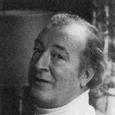French composer Pierre Max Dubois (1930-1995) studied piano with Jean Doyen and composition with Darius Milhaud at the Paris Conservatory between 1949 and 1953. After winning the Prix de Rome in 1955 and the Grand Prix of the city of Paris in 1964, he began conducting and toured France, Belgium, the U.S., and Canada. He taught in Paris and Quebec and eventually taught analysis at the Paris Conservatory. In addition to his woodwind compositions, Dubois also composed three small-scale operas, a number of ballets, and numerous piano works. His other flute works include Incantation et Danse for flute alone and Novelette, Pop Variations, Neuf Preludes Faciels and Sonate, all for flute and piano.
His compositional style is individual, but you can hear influences of Milhaud, Francoix, and Prokofiev, as well as jazz and folk song in his works. He wrote a few unusually orchestrated pieces, including a quartet for four trombones accompanied by full orchestra and saxophone orchestra. His principal publishers are Boosey & Hawkes, Choudens, Eschig, Alphonse-Leduc, Rideau Rouge, and Technisonor.
I. Presto leggiero quarter =138
.jpg)
This movement should be performed as close to the indicated tempo as possible. Because it begins softly with constant moving 16ths and numerous accidentals, the movement is technically challenging, both for fingers and the tongue. Beyond that, however, is the hurdle of playing it musically.
Practice rhythms help to sort out the technical problems and improve rhythmic accuracy and finger evenness. For example, measures 6-8 and 13-16
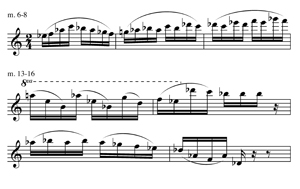

could be practiced with these variations.
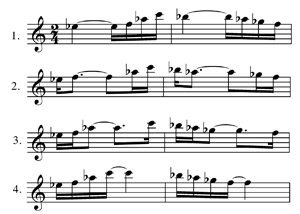

Count measures 37-38 carefully and play the triplet evenly over two beats. Thinking in a quarter-note triplet helps.


Measure 39 is an eighth-note quintuplet over the piano’s eighth and 16th notes. To play five notes over two, think the measure in one big beat while saying hippopotamus.
Measures 41-44 are another great place to use practice rhythms. The following patterns work well here as do dotted rhythms.
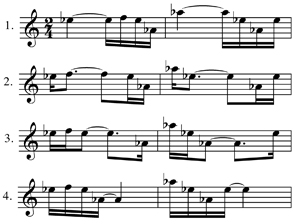

Passages such as bars 49-52 can be a challenge because they are a compilation of half and whole steps. Regrouping them across barlines, as in Kincaid groups, often solves the problem. Marking the half steps and practicing in various rhythms helps as well.
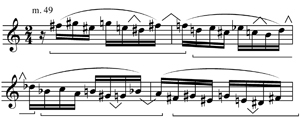

Note that the ff scale beginning in measure 61 starts in F major, switches to C Major in 62, and returns to F major in 64. Toss off the 16th-note quintuplet in 6/8 and treat it as a pickup to the 32nd-note run into measure 69. Adding right-hand ring and middle fingers to the high A flat on the downbeat of 69 will bring the pitch down. This occurs many times throughout the piece.


Trill fingerings or harmonics can be used in measure 95 for clarity. I suggest overblowing the fundamental, as in the following:
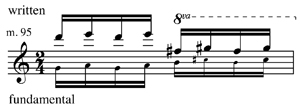

Throughout measures 99-106 it is a good idea to add the right-hand ring finger to the high Fns to bring the pitch down. For the same reason, finger the high F#s in measures 112-114 with the middle right-hand finger.
Identify and write the scale keys in the music so your fingers can function automatically. This is useful in bars 118-121 and 124-126.
A good fingering for the high A to B trill in measure 148 is Th 2 3/ 4 6. (The red numbers indicate the keys that move.)
The remainder of the movement is a romp to the end. Various themes return from earlier in the piece and become transformed into something new. The important thing to remember is to identify the scale keys and patterns wherever they occur. Then your fingers can function almost automatically.
II. Pavane (Lento)

A pavane in the 16th and 17th centuries was a duple-meter, majestic processional dance used to open a ball at court, ostensibly so the dancers could show off their elegant attire. With that in mind, and with the lento indication taken into consideration as well, I suggest a tempo around eighth = 64.
The doppio tempo marking in measure 16 indicates that the tempo doubles in speed. While the basic pulse remains the same, the note value that equals 64 changes to a quarter note rather than the eighth note. The notes values slow down again after measure 34, but again, the basic pulse of 64 remains constant.
As in the first movement, the Pavane includes a few triplet figures that should be spread evenly over the beat, such as in measures 2, 4, 6, and 7. In each case, the piano part has duples in eighth notes.
The opening theme returns in measure 38 at a p level. The final note, an harmonic A, follows just eight measures later. Finger low D and lip up to the A above the staff.
III. Tempo di Gavotto


The gavotte was a Baroque dance form that was quite popular in the court of King Louis XIV. Generally in 4/4 or 2/2, it was felt in two beats to the bar. In this case, a playful tempo around half note = 83 is appropriate. Notice that the harmonies in the piano part change in half-note units, another indication that the movement should be felt in two. Playing the mordent on the downbeat of measure 3 directly on the beat, not before it, will immediately help to establish the feeling of weight on beats one and three.
Use forward motion in measures 17-19 through the eighths by regrouping the notes so that the second through fourth notes of each four-note group lean toward the first note of the next group.

Notice the step-wise motion that occurs on beats one and three in measures 21-24. While the motion is in eighth notes, a little weight on the first note of each group of four (C#, D, E, F#, G, A, and B) will bring out the larger phrase.
In measure 53 after the 44 is the return of the initial measures one octave higher. The last note in 52, the high A, is a pickup to 53. Rubato in the previous measure will help you set that up.
The last note of the movement is written as a quarter, but I suggest lengthening it just a bit, so it doesn’t sound too short and clipped.
IV. Scherzando- dotted quarter note = 83

This movement is marked spirituoso, which requires a flawless technique in order to sound light and easy. The tempo is quite brisk. I recommend practicing with a metronome set on a slow three beats to the measure. Speed up gradually, finally reaching eighth note =252. Working in this way will also provide stability for the rhythm, particularly in those measures that begin with a 16th rest, such as measures 3 and 4 in which the piano and flute both have rests on the downbeats.
The octave E drop in measure 11 will be smooth if you remove the right-hand pinky finger for the middle E natural. This is actually a good technique to use throughout the rest of the movement as well.
Use the B-flat lever or side key in measure 12 for a smooth ascending run, and in all instances in which an alternate fingering would improve intonation feel free to do so. The tempo is such that any variation of tone color due to its use will go unnoticed.
Note that the movement begins softly, and remains that way for most of the first page. Budget the dynamics carefully so there is room to grow to the ffs that follow.
